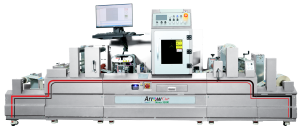The Benefits of Digital Finishing
What is Print Finishing?
While not the first thing many people will think of in terms of printing custom labels or packaging, your finishing solution is just as important as the press you’ve decided to purchase.
New innovations in digital printing technology and the constant demand for shorter print runs have led to a proportional increase in demand for high speed digital finishing systems. These finishing systems protect, define and embellish your prints through inline or offline methods to help create durable, attractive prints
Types of Finishing Methods:
There are many different types of finishing methods, from simple full cuts to foiling and embellishments. Die-cutting is the most well known method in regards to finishing your labels, but there are a number of other things that can be done to help make your labels pop.
Varnishes and laminates can be used in the finishing process to give your label a specific look or feel. You should use a varnish or laminate when you want to protect your printed label from exposure to the elements such as; moisture, abrasion and light, as well as things like smudges and fingerprints.
Printing varnish or laminate can also boost the visual appeal of your label with a smoother, glossier finish. If you want to preserve your label from these dangers while also keeping it looking good for a long time, you should consider a varnish or finish to protect them.
Perforations can be used as a tamper evident solution for labels that go on a variety of packaged products, specifically those which have expiration dates once opened, or can be easily counterfeited.

Full cut’s can be used to remove a specific portion of your label and leave a gap in the material so your product can be seen while it is still in the package. This is regularly used for tape and cannabis labels.
Analog Finishing:
Traditional printing methods have led to the introduction of digital printing that we are familiar with today. Regardless of the innovations, traditional printing presses and finishing systems have been a staple in the industry. They’re the benchmark standard for quality and promise to provide it to your business at speeds other presses can’t imagine competing with.
Analog printing as we are familiar with, uses printing plates in order to print the desired product. Their finishing systems require so
mething similar in the terms of a “signature”. Though the limitations of the printing plate technology have led to the rise in digital prints, offset finishing systems are perfect for large quantities at high speeds. If your company quickly needs to scale up to larger production quantities, traditional printing and finishing methods will suit your needs well.
Digital Finishing:
In comparison to digital methods, finishing with traditional technology begins at a lower initial cost. Typically, these machines are less expensive than laser technology. Keep in mind, however, that even though the initial cost is lower the maintenance costs do tend to catch up.
The downtime to changing over jobs, maintenance or consumables adds up over time. In traditional methods, downtime and the pause in skilled labor are very expensive.
Digital finishing, on the other hand, works similarly to your digital printing press. It works by interpreting a digital file and finishing the label or print. As the market continues to shift towards shorter, more customized runs the increase in digital finishing will increase as well. They offer flexible control over your digital prints.
Laser finishing systems are cost-effective despite the higher initial cost of the system. They allow your reduced production cost to pay for the initial investment of the machine. The reasoning for this is the flexibility that laser die-cutting machines are able to offer. The opportunity to switch seamlessly from job to job with little to no downtime is a huge advantage of digital finishing systems.
Downtime can become extremely expensive in traditional methods. Skilled labor is a significant cost for businesses and when they sit idle as the machine is prepared between jobs it can cost your business a lot of money. The cost effectiveness of using a digital finisher far outweighs using a manual die cutter for your short run production.
Finding the Right Solution for Your Business:
Industrial die-cutting machines may seem daunting, but they’re much easier to operate than one might assume. Digital printing technology has made it simple in training, a few days with a few employees is generally all your team needs before it’s up and operating! In less time, your business will be producing precise, attractive labels for your customers or products.
Pairing a finishing system along with the right printer is a perfect way to decrease on lead times and increase your profit margin, cutting costs and bumping up your production value without compromising on the quality of your work.
